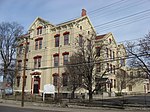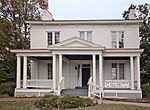Ford Motor Company Cincinnati Plant
Chicago school architecture in OhioFord factoriesHamilton County, Ohio Registered Historic Place stubsIndustrial buildings and structures on the National Register of Historic Places in OhioMotor vehicle assembly plants in Ohio ... and 4 more
Motor vehicle manufacturing plants on the National Register of Historic PlacesNational Register of Historic Places in CincinnatiOffice buildings in CincinnatiTransportation buildings and structures on the National Register of Historic Places in Ohio

Ford Motor Company Cincinnati Plant is a registered historic building in Cincinnati, Ohio, listed in the National Register on May 25, 1989. The former manufacturing plant was transformed in 2002 into office space. As of 2017, the building is owned by Cincinnati Children's.
Excerpt from the Wikipedia article Ford Motor Company Cincinnati Plant (License: CC BY-SA 3.0, Authors, Images).Ford Motor Company Cincinnati Plant
Lincoln Avenue, Cincinnati Avondale
Geographical coordinates (GPS) Address Nearby Places Show on map
Geographical coordinates (GPS)
| Latitude | Longitude |
|---|---|
| N 39.132688888889 ° | E -84.493613888889 ° |
Address
Lincoln Avenue 698
45206 Cincinnati, Avondale
Ohio, United States
Open on Google Maps










